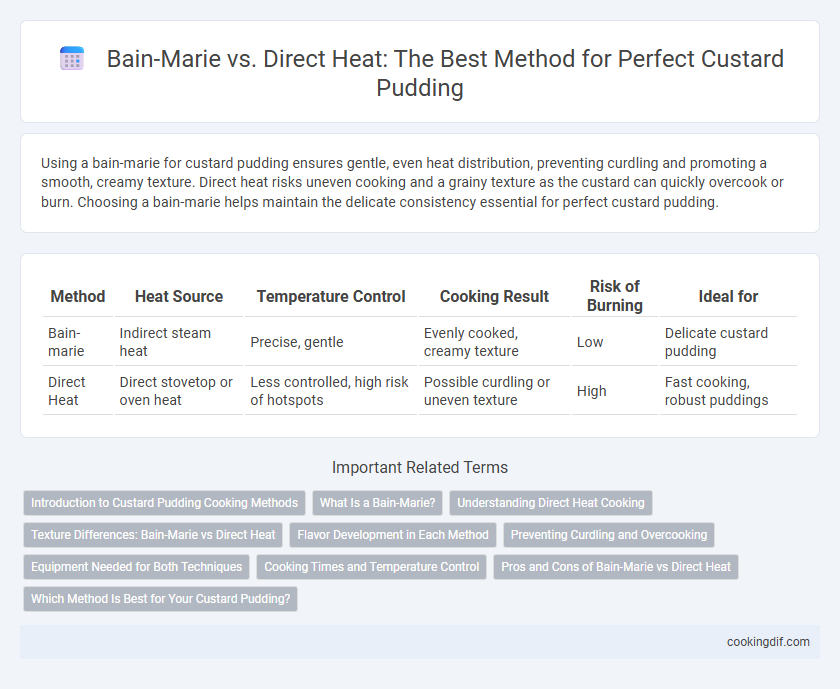Using a bain-marie for custard pudding ensures gentle, even heat distribution, preventing curdling and promoting a smooth, creamy texture. Direct heat risks uneven cooking and a grainy texture as the custard can quickly overcook or burn. Choosing a bain-marie helps maintain the delicate consistency essential for perfect custard pudding.
Table of Comparison
| Method | Heat Source | Temperature Control | Cooking Result | Risk of Burning | Ideal for |
|---|---|---|---|---|---|
| Bain-marie | Indirect steam heat | Precise, gentle | Evenly cooked, creamy texture | Low | Delicate custard pudding |
| Direct Heat | Direct stovetop or oven heat | Less controlled, high risk of hotspots | Possible curdling or uneven texture | High | Fast cooking, robust puddings |
Introduction to Custard Pudding Cooking Methods
Custard pudding requires precise temperature control to achieve its smooth texture, making the choice between bain-marie and direct heat methods crucial. The bain-marie method involves cooking the pudding in a water bath, providing gentle, even heat that prevents curdling and ensures a creamy consistency. In contrast, direct heat subjects the custard to higher temperatures quickly, risking overcooking and a grainy texture, thus requiring constant stirring and careful monitoring.
What Is a Bain-Marie?
A bain-marie, also known as a water bath, is a cooking method that gently heats custard pudding by placing the container in a larger pan filled with hot water, ensuring even and controlled temperature distribution. This technique prevents the pudding from curdling or overcooking by avoiding direct contact with intense heat, which is a common risk when using direct heat methods. The bain-marie is essential for delicate desserts like custard pudding, providing a smooth texture and consistent results.
Understanding Direct Heat Cooking
Direct heat cooking involves applying heat directly to the custard pudding mixture, which can cause rapid temperature changes leading to uneven cooking or curdling due to protein coagulation. This method requires constant stirring and close temperature monitoring to prevent burning or overcooking, as custard is sensitive to high heat. Understanding the delicate thermodynamics of custard proteins helps optimize texture and prevents graininess often encountered with direct heat.
Texture Differences: Bain-Marie vs Direct Heat
Using a bain-marie for custard pudding results in a smoother, creamier texture due to gentle, even heat that prevents curdling and ensures delicate coagulation of egg proteins. Direct heat often produces a firmer, denser texture with risks of overcooking and uneven consistency because of rapid temperature changes. The controlled temperature environment of a bain-marie is optimal for achieving the classic silky mouthfeel characteristic of high-quality custard puddings.
Flavor Development in Each Method
Using a bain-marie for custard pudding ensures gentle, even heat that prevents curdling and promotes smooth, creamy texture, enhancing subtle vanilla and dairy notes. Direct heat can accelerate caramelization and Maillard reactions on the pudding's surface, intensifying flavor complexity but risking uneven cooking or a grainy texture. Flavor-wise, bain-marie preserves delicate aromatic compounds, while direct heat encourages bolder, toasted flavors through localized browning.
Preventing Curdling and Overcooking
Using a bain-marie for custard pudding provides gentle, even heat that prevents curdling by maintaining a stable temperature around 80-85degC, avoiding direct contact with heat that can cause protein coagulation. Direct heat risks hotspots and rapid temperature increase, leading to overcooked edges and a grainy texture. The bain-marie method ensures smooth, creamy custard with consistent doneness throughout the pudding.
Equipment Needed for Both Techniques
Preparing custard pudding with a bain-marie requires a deep ovenproof dish or roasting pan to hold hot water and a heatproof bowl or ramekins for the custard mixture, ensuring gentle, even cooking. Direct heat cooking demands a heavy-bottomed saucepan or double boiler to prevent scorching while stirring continuously. Proper equipment selection is crucial for texture control and preventing curdling in custard puddings.
Cooking Times and Temperature Control
Using a bain-marie for custard pudding ensures gentle, even heat distribution, preventing curdling by maintaining a steady temperature around 80-90degC (176-194degF). Cooking times in a bain-marie typically extend to 40-50 minutes, allowing the custard to set slowly and achieve a creamy texture. Direct heat risks overheating the mixture above 100degC (212degF), causing quicker cooking within 15-25 minutes but often leads to uneven texture and potential burning due to poor temperature control.
Pros and Cons of Bain-Marie vs Direct Heat
Bain-marie provides gentle, even heat that prevents custard pudding from curdling and ensures smooth, creamy texture, but it requires longer cooking time and constant water level monitoring. Direct heat offers faster cooking and easier temperature control, yet it risks uneven cooking and overheating, which can cause the pudding to become grainy or burnt. Choosing bain-marie minimizes the risk of texture issues in delicate custards, while direct heat suits recipes prioritizing speed over precision.
Which Method Is Best for Your Custard Pudding?
Using a bain-marie for custard pudding ensures gentle, even heat, preventing curdling and promoting a smooth, creamy texture. Direct heat risks uneven cooking and can cause the custard to scramble or develop a grainy consistency. For consistent, delicate custard pudding results, the bain-marie method is generally preferable.
Bain-marie vs direct heat for custard pudding Infographic

 cookingdif.com
cookingdif.com